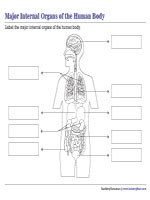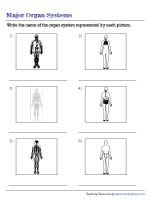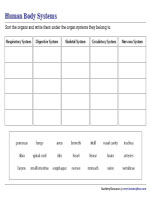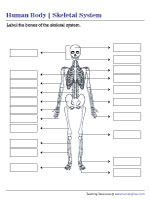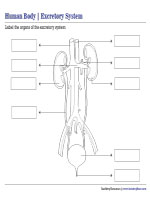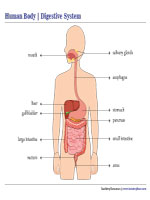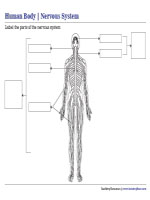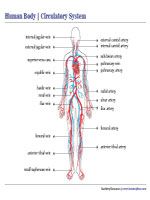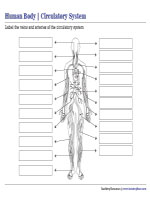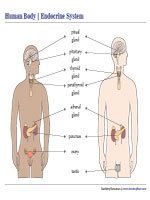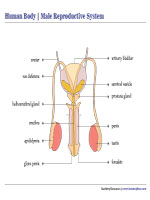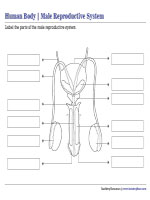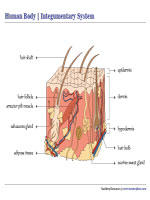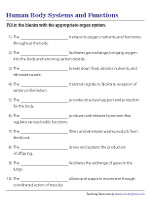Human Body Systems Worksheets
- Science >
- Human Body Systems
Our printable human body systems worksheets help learners discover the inner workings of organ groups that band together for life to thrive. The skeletal system provides a bony framework, the muscular system offers mobility, the nervous system makes sensation possible, and the reproductive system sustains procreation. Explore many such organ systems in this collection.
These free human body systems worksheets are best suited for grade 3 through grade 8 students.
A neatly labeled diagram of the human body, showcasing the relative placement of major internal organs such as the liver, kidneys, stomach and lungs dominates this colorful chart.
Labeling Major Internal Organs
The heart pumps blood, while the brain controls the vast majority of bodily processes. Keep in mind the functions of the major internal organs and label them accordingly.
Direct the young anatomists in grade 3 and grade 4 to recognize the organ systems of the human body depicted in the pictures, making sure to write the names in the space given.
Sorting Organs into Organ Systems
The systems of the human body work in harmony to ensure life flourishes. Remember this key fact when sorting the organs in this printable worksheet based on their organ systems.
Quite literally the backbone of the human body, the skeletal system provides sturdy support for the body. Tackle the different bones that make up the body's frame using this chart.
Labeling Parts of the Skeletal System
Acquaintance with the bones that form the human skeleton is a prerequisite for success in this section of our organ systems worksheets. Identify the types of bones and label them.
It is impossible to overstate the importance of the excretory system, for blood purification hinges on this group of organs. Get to know the kidneys, bladder, and more in this exercise.
Labeling Parts of the Excretory System
While the ureter, urethra, and kidneys are relatively easy to locate and mark, the renal veins and arteries may pose a bit of a challenge. Hone in on them and complete this pdf.
Greet the process of gaseous exchange in this part of our human body systems worksheets. Say hello to nasal and oral cavities, move on to the lungs, and down toward the diaphragm.
Labeling Parts of the Respiratory System
Recollect the functions and significance of the respiratory system while labeling its parts in this segment. To make things easier, simply follow the path of oxygen as it enters the body.
Teach 3rd grade and 4th grade kids that digestion begins the moment saliva comes in contact with food, as they look at the organs of the digestive system in this printable chart.
Labeling Parts of the Digestive System
Digestion begins at the mouth, takes place predominantly in the abdominal cavity, and ends in the rectum. Repeat this mantra when naming the stomach, pancreas, liver, and more.
Delight grade 4 and grade 5 kids with this chart, where the central and peripheral nervous systems take turns to shine. Learn how sensory signals are transmitted across the body.
Labeling Parts of the Nervous System
Understand how the brain communicates with the rest of the body through an intricate network of nerves. Label the brain and spinal cord among other parts in this exercise.
Here's another labeled diagram adding depth and volume to our printable human body systems worksheets. It is time for the muscular system to wow the audience with its strength.
Labeling Parts of the Muscular System
The headquarters of movement, the muscular system is the reason we can walk and run. Instruct 4th grade and 5th grade learners to label the different muscle groups in this pdf.
Imagine a complex matrix of tubes carrying blood through the body, delivering oxygen and nutrients to the cells. Such is the structure of the circulatory system, as shown in this chart.
Labeling Parts of the Circulatory System
Augment grade 6 and grade 7 students' grasp over human biology with this printable, where the task is for them to name the parts of the circulatory system depicted in the diagram.
Highlighting the significance of the body's delicate hormonal balance, this segment of our human body systems worksheets direct their focus on specialized organs known as glands.
Labeling Parts of the Endocrine System
Remember the names of the hormones, and the names of the glands will follow suit. From head to toe, locate the glands that secrete vital hormones and write their names down.
Female Reproductive System Chart
The gift of life would never reach posterity if not for the female reproductive system, featured with all its parts in this printable chart for 6th grade and 7th grade students.
Labeling Female Reproductive System
Crucial for the continuance of the circle of life, the female reproductive system and its functioning are an essential part of anatomy sessions. Label the organs that make up this system.
Male Reproductive System Chart
The journey of life from one generation to the next cannot be fulfilled without the male reproductive system. Make kids aware of its significance with the labeled diagram in this chart.
Labeling Male Reproductive System
Put your grasp of organ systems to the test with this systems of the human body worksheet. Identify and label the vas deferens, testis, and other parts of the male reproductive apparatus.
Equal parts simple and effective, this chart belongs on every 7th grade and 8th grade learner's study wall. It features a clearly labeled diagram of the human integumentary system.
Labeling Parts of the Integumentary System
Keep in mind that the hypodermis forms the base, resting beneath the dermis, which in turn lies under the epidermis. Make sure to name every part of the integumentary system.
Matching Human Body Systems to Functions
Survival rests upon the fact that every organ system is as important as the next one. Recall the specialized role each system plays, and pair them up appropriately in this exercise.
Completing Statements on Human Body Systems
Round out the session with a review of the functions of human body systems. Brush up on the fact that the nervous system transmits signal, the circulatory system carries blood, and more.


